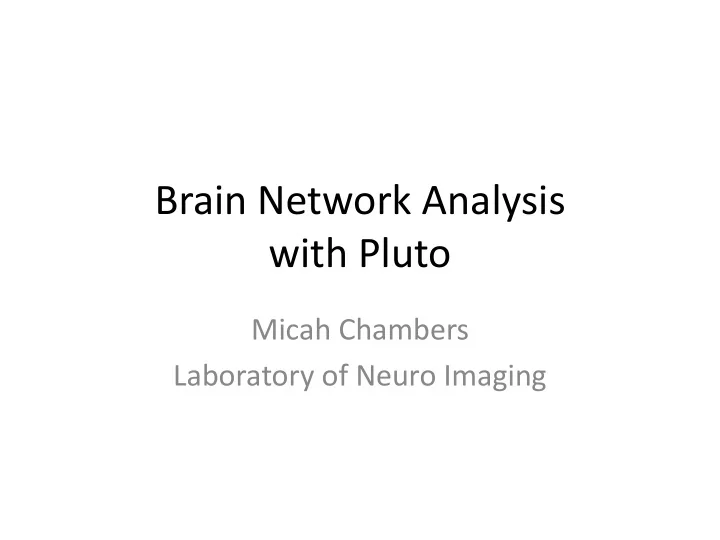

Brain Network Analysis with Pluto Micah Chambers Laboratory of Neuro Imaging
Graph Theory and the Brain • Made up of Nodes and Edges – Node: Brain Region (e.g. V5) or Single Voxel – Edge: Direct Connection between Nodes (e.g. Corpus Callosal Fiber) • Mathematical Formalization of Connectivity • Allows researchers to characterize communication – “small world networks” – Random networks • Look for subtle patterns – Not visible at a glance – vs. easily visible effects such as lesions • Pluto Tools makes these fast and easy Published Papers Featuring “Graph Theory” and “Brain”
Overview fMRI Cortical Parcellation Map Diffusion Tractography Voxel-Voxel Functional Regional Functional Regional Structural Connectivity Connectivity Connectivity
Node Statistics • Clustering Coefficient – Ratio of Realized vs. Potential Triangles • Degree – Number of Edges Clustering Coefficient • Strength – Sum of Weights Degree Strength
Distance Metrics • All Shortest Paths • Edge Betweenness – Number of Shortests Paths Traversing the edge Edge Betweenness Shortest Path
Distance Metrics • Betweenness Centrality – Number of Shortest Paths Containing the Vertex • Eccentricity – Length of the longest shortest path for a vertex Betweenness Centrality • Characteristic Path Length Eccentricity – Average Shortest Path • Radius – Minimum of Eccentricity • Diameter – Maximum of Eccentricity
Distance Metrics • Local Efficiency – Sum of Reciprocal Shortest Paths in subgraph • Edge Range – “Shortcut” Paths – change in path length after removing a path Local Efficiency Edge Range
Other Metrics • Louvain Modularity • Assortivity – Correlation of Degree Between Connected Vertices Louvain Modularity • Matching Index Matching Index Low Assortivity High Assortivity
Pluto Tools Overview • micor : timeseries similiarity fMRI Fiber Tracts – Calculates voxel-voxel mutual information or correlation • gCalcAdj : Fiber Counts Timeseries – Regional Fiber Timeseries Counts – Count between regions or Similiarity mesh-points Resample to • gRed : Resampling Point-Wise Larger Regions Fiber Counts (optional) – calculate regional averages of connectivity • gRed : Graph Theory Adjacency Matrix – Calculate Metrics using Graph Theory Graph Theoretic Metrics
Functional Connectivity Calculation • Required Input: – fMRI Image – Labelmap Image – Nearest N. Resampling Handled Internally • Required Output: – Adjacency Matrix Stored in vtkImageData • Lags: number of TR’s to lag in search of maximal connectivity (2L+1) • Metrics: – Correlation, “-c” (Recommended in Pipeline, < 1 hour runtime) – Mutual Information (Not Recommended in Pipeline, 10+ Hour runtime) – Mutual Information with Interpolation (Not Recommended in Pipeline, Day+ Runtime) • Outside Pipeline: “-G” to use GPU
Structural Connectivity Calculation • Required Input: – Vertices Either: • Point List “-p” • Label Map Image “-L” – Input Data Either: • Existing Adj. Matrix “-a” • Fiber Tracts “-t” • Filter out short tracts with “-m <length>” – Very short tracts are often considered noise
Graph Modification • Keep Only List of Nodes – e.g. List of cortical Regions • Remove List of Nodes – e.g. Ventricles – Extremely important when calculating shortest paths • Graph Simplification: – Average Connectivity over Label-Pairs – Percentile over Label-Pairs – Optional Inclusion of Zeros in statistics
Graph Statistics “-S” • Compute Statistic “-S”: – Betweenness Centrality – Clustering Coefficient – Degree – Strength – Eccentricity – Local Efficiency – Shortest Path – Edge Range – Edge Betweeness – Matching Index – Joint Degree – Assortivity – Characteristic Path Length – Diameter – Radius – Global Efficiency – Louvain Modularity – Invert Elements (for converting weight to distance)
Odds and Ends • gTxtToVtk – Input: CSV Adjacency Matrix – Output: vtkImageData • gVtkToTxt – Input: vtkImageData – Output: CSV Adjacency Matrix • trkToVtk – Input: trackvis .trk file – Output: vtkPolyLines
Conclusions • Native C++ Code – Source Available for Request – Compiled Versions at /ifs/students/mchambers/pluto-0.5 • Pipelines Available Now – Make interfacing with other tools far easier • GPU Support for functional connectivity (outside pipeline) – More may be added for slower graph-metrics • Designed For Neuro Imaging Applications – Wide Variety of Input Image Types (nifti preferred) – Easily Convertible VTK format, tools included • Please Contact Me at: – micahcc@ucla.edu – Come talk to me at the Ice Cream Social
Recommend
More recommend